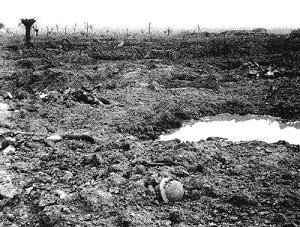
|
| Passchendaele July 31 - November 8, 1917 |
They Call It Passchendaele
Passchendaele (officially the third battle of Ypres) is outstanding among the battles of World War I not only for its
cost, but also for the conditions in which those casualties were incurred. The British commander, Sir Douglas Haig, had decided
to launch his forces from the Ypres salient -- the loop in the front line around the city which they had been holding since
October 1914. Their aim was the German-occupied ports on the Belgian coast to the north-east.
The overture, on 7 June 1917 was the battle of Messines. It was a success, albeit at a cost of 24,000 casualties. The
British exploded 19 huge underground mines, and then stormed the ridge overlooking Ypres from the south. But what followed
was to be far more difficult. The main attack went in over low-lying land veined by water courses. Constant shelling had churned
the clay soil and smashed the drainage systems. The heavy rains which coincided with the opening assault, on 31 July, produced
thick, clinging mud, which caked uniforms and clogged rifles.
It eventually became so deep that, in many places, men, horses and pack mules drowned in it. The shell holes filled with
water. With each new phase of the offensive, fresh rain fell to add to the misery.
The only solid objects in the desolation seemed to be the concrete German strong-points, built to give their occupants
inter-locking fields of machine gun fire which scythed down many attackers. Despite this, the offensive continued, in fits
and starts, throughout the summer and into autumn. It petered out in November, when the Canadians reached the site of the
village which gave the battle its name. Hardly a trace of it remained. What was supposed to be a thrusting breakthrough became
a battle of attrition. The British and Empire forces advanced just five miles, at a cost of at least a quarter of a million
casualties. Their one consolation was that the Germans had also suffered grievously.
Perhaps the battle's enduring epitaph is the phrase from one of Siegfried Sassoon's poems:
''I died in hell - They called it Passchendaele''
|
could be described as one
of the most controversial
battles of World War I.
this page from the
government of Canada
archives
the symbol of the
stupidity of war
this page is part
of an overall
website entitled
Europe's 20th Century Journey.
from Liverpool Community College
in the UK.
an overview from the
Canadian point of view.
this is at the vast About
website
an audio eye-witness account
of the \Canadian involvement.
this from the
CBC Canada Archives
another look at
the Canadia Corp's
involvement in this
futile and costly battle
this site has a photograph
of the Canadian Memorial
at Passchendaele

|

